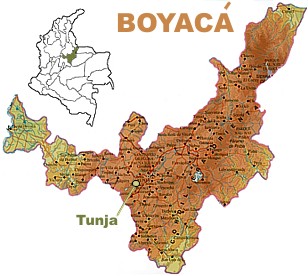 BOYACA
Inhabitant: Boyacense
BOYACA
Inhabitant: Boyacense
In the languages of
Chibcha or Muisca, Boyacá
means 'Surroundings of the Overlord' or 'Region of Blankets'. When the
Republic of Colombia was born, Boyacá received the title “the
origins and the road to freedom” because the first battles for
emancipation of the
Bolivarianos countries were planned and
won in Boyacá.
The department was created by virtue of the 1886 Constitution. It was
the land of the
Muisca natives. Many descendants of that great
civilization still live in the region.
Its territory covers an area of 23,189 square kilometers and about
1,400,000 people live there. Boyacá lies in central-east
Colombia and it borders the departments of Santander, Norte de
Santander, Antioquia, Meta,
Cundinamarca, Casanare and Arauca, and the Republic of Venezuela.
This department has many different climates, from the very hot climate
in the low region of Puerto Boyacá to the very cold temperatures
in the high altitudes and snow-capped mountains Nevado de Güican
and Sierra Nevada del Cocuy .
Boyacá is rich in iron deposits, particularly in the region where
the Paz del Río steel mill is located. It is also rich in
asphalt, silver, kaolin, quartz and the emerald mines of Muzo and Chvior
where the most beautiful and valuable emeralds in the world are
extracted. Furthermore, Boyacá is an important center of
handicrafts.
Tota Lake is one of the prettiest spots in the department; so are the
natural national parks of El Cocuy, Iguaque and Pisba. There are also
important national and historic monuments such as El Pantano de Vargas,
La Ruta Libertadora in Paipa, the train station of Chiquinquirá,
the Bridge of Boyacá, the Sanctuary of Iguaque, the desert of La
Candelaria and the valley of Tenza, among others.
Villa de Leyva is one of the best preserved cities in Colombia.
Capital: Tunja
Its name comes from the Chibcha natives tribe word
tchunza,
which means “territory of the
Z aques overlords
” .
Tunja is a historic city with beautiful colonial architecture. It is
also known as “the city of hidden treasures”. Big colonial houses, full
of geraniums and flowers that thrive in cold weather, enhance the beauty
of this city, home to about 200,000 people. The average temperature of
Tunja ranges from 10 to 13 degrees Celsius. Tunja is the coldest city in
Colombia.
Historic places like
la Casa del Fundador , (“the
Founder's House”),
el Pozo de Donado, (the “Well of Donado”,)
el Monumento a La Raza , (“the monument honoring ‘The Race'”),
el Monumento al Trigo (“the Wheat Monument”) called
La
Fuente Grande (“ the Large Source”) and the Church of Santo Domingo
are remarkable tourist attractions. The famous Bridge of Boyacá
is located 14 kilometers from Tunja.
It is worth mentioning that the first Colombian painting was registered
in Tunja. It is the Virgin of Chiquinquirá image, painted on a
native blanket by the Spanish artist Alonso de Narváez in 1551.




